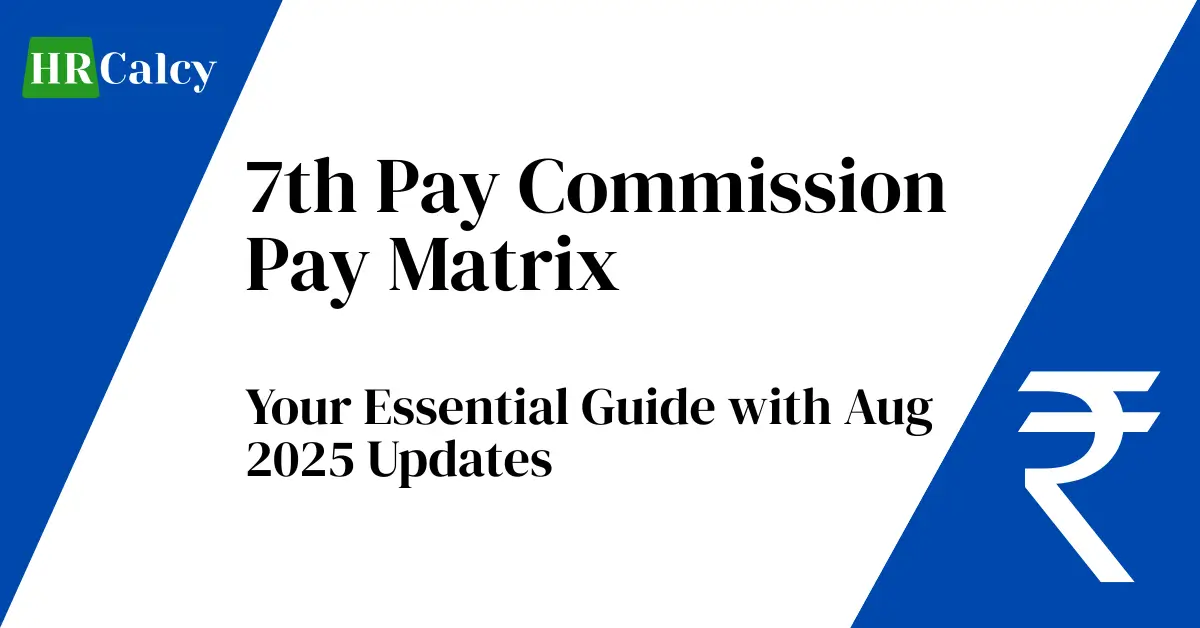Get the latest 7th Pay Commission pay matrix 2025 details with updated DA, salary levels, and examples. Learn how increments, promotions, and allowances impact your take-home pay. Clear, verified, and easy-to-follow guide for employees.
Table of Contents
Introduction: Clarity on the Pay Structure
Understanding the 7th Pay Commission pay matrix is pivotal if you’re a central government employee or pensioner aiming to grasp your salary structure clearly. In this guide, you’ll find a concise yet engaging breakdown on how the pay hierarchy works, the very latest update on Dearness Allowance (DA), and how all of it shapes your monthly earnings.
We’ll begin with how the matrix is structured and how to read it. Then, we’ll connect you with trusted resources to confirm the most up-to-date figures—ensuring you’re working with accurate, verified information right now, as of mid-2025.
8th Pay Commission Salary Calculator
7th Pay Commission Pay Matrix
8th Pay Commission Pay Matrix
8th CPC Fitment Factor Calculator
Dearness Allowance Calculator
DA Arrears Calculator
7th CPC Pension Calculator
8th CPC Pension Calculator
What Is the Pay Matrix?
- At its core, the 7th Pay Commission pay matrix is a streamlined salary grid introduced in 2016 that replaced the older band plus grade-pay format with a unified, transparent structure.
- The grid has 19 levels (numbered 1–18, with 13A included) and 40 stages (or indices) per level—totalling 760 cells. Your pay is determined by finding the correct level and stage intersection.
- For instance, Level 1 starts at ₹18,000, while higher levels (e.g., Level 5 or Level 10) have their own pay progression paths. This allows you to visualize growth over time clearly.
You can explore an interactive version of the matrix here.
July 2025 Update: Dearness Allowance (DA)
The DA, which helps offset inflation, has seen a recent hike:
- In early 2025, DA was raised from 53% to 55%, becoming effective from 1 January 2025.
(This was confirmed via a government order; check the official source for full details.) - And—important to note—many media reports now suggest a further 3–4% increase, bringing DA to approximately 58% effective from July 2025. This is expected to be the final DA adjustment under the 7th Commission, with disbursements likely around October during the festive season.
Why This Matters
- The DA forms part of your basic pay slab, which means any increase directly elevates allowances tied to it.
- Knowing your current DA percentage and pay level helps you accurately estimate total compensation—plan effectively, whether it’s for budgeting or promotion timelines.
Quick Snapshot: DA Progression (2025)
| Date | DA Percentage |
|---|---|
| 1 Jan 2025 | 55% |
| July 2025 (expected) | ~58% |
Decoding the Pay Matrix: Structure and Navigation
The 7th Pay Commission pay matrix is designed for clarity and fairness. Its grid spans 19 levels (1 to 18, including 13A), each featuring up to 40 progression stages. This structure ensures that career advancement—both through seniority and promotion—translates into transparent and incremental pay increases.
Understanding the Layout
- Horizontal axis indicates pay levels, ranging from entry-level starting at ₹18,000 (Level 1) to apex-level salaries touching around ₹2.5 lakh (Level 18).
- Vertical axis shows progression through annual increments or promotions within each level.
You can view a simplified version of the matrix on BankBazaar’s pay matrix page or obtain the detailed official grid via the Department of Expenditure’s site.
Quick Reference: Entry and Apex Levels
| Pay Level | Entry Pay (₹) | Approx. Max Pay (₹) |
|---|---|---|
| Level 1 | 18,000 | ~55,000 |
| Level 10 | 56,100 | ~80,000 |
| Level 18 | — | ~250,000 |
These figures are examples—precise values differ by level and stage—but they offer a useful benchmark for visualizing the pay journey.
How to Identify Your Pay Cell
Here’s how you locate your exact pay within the matrix:
- Determine your level based on your post, grade, or designation.
- Locate your current stage or index—this reflects how far you’ve progressed.
- Match the two axes—the intersection is your current basic pay.
For example, a Level 6 employee at Stage 3 will find the corresponding pay cell directly where those two criteria cross. If you’re unsure, tools like the 7th CPC salary calculators available online can help you estimate your basic, DA, HRA, and total pay at a glance.
Why This Design Matters
- It replaces earlier, complex grade-pay structures with a unified system—easy to understand and administer.
- You can visually map your career growth, both horizontally (promotions) and vertically (increments).
- This transparency helps reduce errors, ensures equity across cadres, and simplifies audits and salary fixes.
Understanding the Latest Shifts: Dearness Allowance & Pay Levels
Building on how the structure works, let’s walk through what’s changed recently—especially for those following the 7th Pay Commission pay matrix closely.
Final DA Update Under the 7th Pay Commission
The Dearness Allowance (DA), a critical component of take-home salary, has seen one final significant change. By mid-2025, central government employees are expecting a 3% to 4% increase, most likely bringing the DA rate to around 58–59%, effective from July 2025. This is set to be the last adjustment under the current framework, with arrears and revised salaries expected to reflect in the October 2025 pay during the festive season.
Why It Matters
Every percentage point in DA affects not just the basic pay, but also influences House Rent Allowance (HRA), Transport Allowance, and other linked benefits. That’s why keeping track of DA changes and mapping them to your level in the pay matrix is essential for accurate financial planning.
Pay Level Benchmarks Across the Matrix
While the pay matrix spans 19 levels and up to 40 progression stages per level, certain benchmarks are often referred to:
| Grade Level | Entry Basic Pay (₹) | Approximate Maximum Pay (₹) |
|---|---|---|
| Level 1 | 18,000 | 56,900 |
| Level 10 | 56,100 | 1,77,500 |
| Level 18 | — | 2,50,000 |
This table shows how the system accommodates everyone—from new recruits entering at Level 1, to senior officials at Level 10, and top-tier posts at Level 18. Having these ranges in view helps employees understand their position today and the trajectory of their career growth within the framework.
This completes the third 20% of your guide—tying the latest DA hike under the 7th Pay Commission directly to how pay progression works across different levels. Next, we’ll move into practical examples, showing how increments and promotions unfold in real roles.
Real-Life Progression: Examples and Fitment Factor
To bring the 7th Pay Commission pay matrix to life, let’s walk through practical scenarios that illustrate how pay increases work—from fitment transitions to real post-based examples.
Fitment Factor Explained Through Illustration
When the matrix was introduced, an employee’s old basic pay (under the 6th Commission system) was multiplied by a fitment factor of 2.57 to fix them into the new grid. For instance, someone earning ₹7,000 previously would land at approximately ₹18,000 in the new system after adjustment. This instantly shows how the matrix offers clarity and fairness in salary alignment. Explore a salary transition calculator to see this in action or review walkthroughs on Qandle’s comprehensive guide.
A Practical Case: Assistant Section Officer at Level 7
Let’s take a fictional employee in Level 7, Stage 3, currently drawing a basic pay of ₹47,600:
- Basic Pay: ₹47,600
- DA (at 58%): ₹27,608
- HRA (27% for metro cities): ₹12,852
- TA: ₹3,600
That brings the gross pay estimate to about ₹91,658. Such calculators bring real transparency to how much one actually takes home in a given city or role.
Snapshot: Stage-Wise Progression in Level 7
| Stage | Approx. Basic Pay (₹) | Total with DA (~58%) |
|---|---|---|
| 1 | 44,900 | 70,982 |
| 3 | 47,600 | 75,248 |
| 5 | 50,800 | 80,144 |
This small table shows how each incremental step within a single level gradually updates both basic and DA-influenced pay.
Final Thoughts
The 7th Pay Commission pay matrix stands out for its clarity, fairness, and adaptability. With its level-stage design, fitment factor alignment, and transparent progression, it continues to serve as a dependable framework—even as DA oscillates and anticipation mounts for the next commission.
Staying updated—especially as monetary revisions and the status of the 8th Commission evolve—will help you manage your career and financial planning with foresight.
If you’d like, I can help with a downloadable PDF version, printable matrix, or reminders when the 8th commission’s official notification arrives.
FAQ
What is the 7th Pay Commission pay matrix?
The 7th Pay Commission pay matrix is a structured salary chart for central government employees, replacing the old grade pay system with transparent levels and stages.
What is the minimum salary under the 7th Pay Commission?
The minimum salary under the 7th Pay Commission pay matrix is ₹18,000, which applies to Level 1 employees at the entry stage.
What is the maximum salary in the 7th Pay Commission?
The maximum salary under the matrix is about ₹2,50,000, which applies to top-level officers such as the Cabinet Secretary.
How is DA calculated in the 7th Pay Commission?
Dearness Allowance (DA) is calculated as a percentage of basic pay. As of July 2025, DA is expected to rise to around 58-59% of basic pay.
How does promotion affect salary in the pay matrix?
A promotion moves an employee horizontally to a higher level in the pay matrix, resulting in a higher basic pay and allowance-linked benefits.
Will the 8th Pay Commission replace the current matrix?
Yes. The 8th Pay Commission has been announced and is expected to come into effect around 2026–27, replacing the existing 7th pay commission pay matrix.
How do I calculate my pay under the 7th Pay Commission?
You can calculate your pay using online salary calculators that factor in your pay level, DA, HRA, and allowances for accurate figures.
Professional Quiz With Free Certificate
Resources
& Finance
Technology
Marketing
& Projects
& Supply Chain

